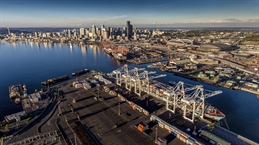
Transpacific container rates have dropped to levels last seen before the Red Sea crisis, signaling a potential end to this year’s peak season surge despite the U.S. government’s recent tariff extension on Chinese goods.
When the U.S. lowered baseline tariffs on Chinese exports from 145% to 30% in May for a 90-day window, ocean freight demand surged. Rates to the West Coast spiked to over US$6,000 per forty-foot equivalent unit (FEU) as shippers rushed to move cargo ahead of the August deadline.
But with the White House announcing a 90-day extension of the reduced tariff, the market response has been mixed. A Freightos poll of roughly 80 supply chain professionals found that half expect another bump in demand, while the other half believe the peak season has already passed. So far, rate trends appear to support the latter.
Transpacific rates to the West Coast fell 8% last week to below US$2,000/FEU—their lowest since the onset of the Red Sea crisis. Daily rates this week have dipped further to US$1,700/FEU, matching levels seen just before Houthi attacks disrupted global shipping in late 2023.
East Coast rates dropped 3% to US$3,472/FEU last week and now sit at US$2,700/FEU, also nearing pre-crisis benchmarks.
"Container rates on the transpacific are falling due to tariff-driven frontloading that saw stronger than normal volumes earlier in the year and brought a brief and early peak season surge back in June," said Judah Levine, head of research at Freightos.
"But rates falling back to levels last seen before the Red Sea crisis began – even as attacks continue – suggest that overcapacity is also playing a role in rate behavior."
Signs of overcapacity are emerging beyond the transpacific. Asia–Europe trade lanes, despite strong volumes and ongoing Red Sea diversions, are seeing rates 60% lower than a year ago.
Last week, Asia–Northern Europe rates held steady at US$3,300/FEU, while Asia–Mediterranean prices slipped to US$3,100/FEU from a mid-June peak of US$4,800/FEU. Carriers plan to reduce capacity in September to prevent further declines.
In air cargo, an Air Canada flight attendant strike in mid-August temporarily froze passenger operations and disrupted cargo flows. A tentative agreement reached late August 18 has allowed services to gradually resume.
Freightos Air Index data shows air cargo rates were mostly stable last week. China–U.S. prices edged up to US$5.44/kg, China–Europe rates dipped 4% to US$3.53/kg, and transatlantic rates fell 2% to US$1.73/kg.



